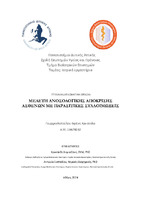Μελέτη ανοσολογικής απόκρισης ασθενών με παρασιτικές συλλοιμώξεις
Study of immune response in patients with parasitic co-infections

Πτυχιακή εργασία
Author
Γεωργουλοπούλου, Ειρήνη Χρυσούλα
Date
2024-03-12Keywords
Συλλοίμωξη ; HIV ; Toxoplasma gondii ; Leishmania infantum ; Κυτταροκίνες ; ELISAAbstract
Στην παρούσα διπλωματική εργασία, μελετήθηκε η ανοσολογική απόκριση των
ασθενών με παρασιτικές συλλοιμώξεις. Προσδιορίστηκε η συγκέντρωση των
κυτταροκινών IFN-γ, IL-10, IL-6, IL-17A και IL-22 στον όρο ασθενών με συλλοίμωξη
HIV(+)/T.gondii(+) και HIV(+)/Leishmania(+). Τα αποτελέσματα των ορών αυτών
συγκρίθηκαν με τις συγκεντρώσεις κυτταροκίνης των ορών ασθενών HIV(+) και των
ορών που ήταν αρνητικοί και για όλα τα παθογόνα. Οι οροί που εξετάστηκαν
παραχωρήθηκαν από το Εθνικό Κέντρο Αναφοράς AIDS Νοτίου Ελλάδος κατά το
χρονικό διάστημα 2019-2020. Εφαρμόστηκε Ενζυμική δοκιμασία
ανοσοπροσρόφησης (ELISA) τύπου “Sandwich” για να προσδιοριστεί η συγκέντρωση
των κυτταροκινών IFN-γ, IL-10, IL-6, IL-17A και IL-22. Οι οροί ομαδοποιήθηκαν στις
κατηγορίες HIV(+)/T.gondii(+), HIV(+)/Leishmania(+), HIV(+), All positive
[HIV(+)/T.gondii(+)/Leishmania(+)] και «All negative» (αρνητικοί για όλα τα
παθογόνα) και «Στικτός» (οροί με αποτελέσματα στικτού ανοσοφθορισμού για το
παρασιτο Leishmania infantum). Οι οροί ασθενών με συλλοιμώξεις δεν παρουσίασαν
σημαντική αύξηση στη παραγωγή της IFN-γ συγκριτικά με τους ορούς ασθενών «All
negative» ούτε με τους ορούς ασθενών HIV(+). Αντιθέτως, παρατηρήθηκε σημαντική
αύξηση στη συγκέντρωση της IL-10 σε πολλά από τα δείγματα ορού ασθενών με
συλλοίμωξη και HIV(+) συγκριτικά με την ομάδα δειγμάτων ορού «All negative».
Ωστόσο, ενας σημαντικός αριθμός ορών δεν συμφωνούσε με αυτή τη παρατήρηση.
Από τα παραπάνω, συμπεραίνουμε ότι παρατηρείται μια τάση προς την Th2
ανοσολογική απόκριση σε πολλά από τα δείγματα ορού με συλλοίμωξη. Εξαιτίας της
μεγάλης διακύμανσης μεταξύ των συγκεντρώσεων της ιδίας κατηγορίας δειγμάτων
ορού, δεν ήταν δυνατή η λήψη συμπεράσματος για την IL-6. Οι οροί ασθενών με
συλλοίμωξη HIV(+)/Leishmania(+) παρουσίασαν αύξηση στη συγκέντρωση της IL-17A
σε σύγκριση τόσο με τους ορούς ασθενών «All negative», όσο και με τους ορούς
ασθενών HIV(+). Οι οροί ασθενών με συλλοίμωξη HIV(+)/T.gondii(+) παρουσίασαν
αυξημένη συγκέντρωση IL-17A σε σύγκριση με τους ορούς ασθενών «All negative»,
αλλά μικρότερη αύξηση συγκριτικά με τους ορούς ασθενών HIV(+). Επομένως, η
παραγωγή της IL-17A βρέθηκε ότι ενισχύεται σε δείγματα ορών από ασθενείς με
συλλοίμωξη που έχουν επιβαρυμένο ανοσοποιητικό, ενισχύοντας περαιτέρω την Th2
ανοσολογική απόκριση. Η IL-22 δεν παράγεται στους ασθενείς με συλλοίμωξη και
φαίνεται πως δεν έχει κάποιο ρόλο στην εξέλιξη της νόσου. Παρόλο που τα
αποτελέσματα της παρούσας εργασίας συμφωνούν ότι η συλλοίμωξη
HIV(+)/T.gondii(+) και HIV(+)/Leishmania(+) έχουν αρνητικό αντίκτυπο στην ανοσία
του ξενιστή όπως είναι αναμενόμενο, και ενισχύουν την Th2 ανοσολογική απόκριση
με εμπλοκή κυρίως των κυττταροκινών IL-17A και IL-10, απαιτείται περαιτέρω
διερεύνηση και πραγματοποίηση περισσοτέρων ερευνών που να εξετάζουν την
έκκριση και συμμετοχή διάφορων κυτταροκινών στον ορό ασθενών με συλλοίμωξη
HIV(+)/T.gondii(+) και HIV(+)/Leishmania(+), για να διευκρινιστεί ο ακριβής
μηχανισμός ανοσολογικής απόκρισης σε αυτές τις καταστάσεις.
Abstract
In this thesis, the immune response of patients with parasitic co-infections was
studied. The concentration of cytokines IFN-γ, IL-10, IL-6, IL-17A and IL-22 was
determined in the sera of patients with HIV(+)/T. gondii(+) and HIV(+)/Leishmania(+)
co-infection. The results of these sera were compared with the cytokine
concentrations of HIV(+) patient sera and sera that were negative for all pathogens.
The sera tested were provided by the National AIDS Reference Center of Southern
Greece during the period 2019-2020. The Sandwich-type Enzyme-Linked
Immunosorbent Assay (ELISA) was applied to determine the concentration of
cytokines IFN-γ, IL-10, IL-6, IL-17A and IL-22. The sera were grouped into
HIV(+)/T.gondii(+), HIV(+)/Leishmania(+), HIV(+), All positive
[HIV(+)/T.gondii(+)/Leishmania(+)] and "All negative" (negative for all pathogens) and
"Spotted" (sera with spotted immunofluorescence results for the parasite Leishmania
infantum). The sera of patients with co-infections did not show a significant increase
in IFN-γ production compared to the sera of "All negative" patients nor to the sera of
HIV(+) patients. In contrast, a significant increase in IL-10 concentration was observed
in many of the serum samples of co-infected and HIV(+) patients compared to the "All
negative" serum sample group. However, a significant number of sera did not agree
with this observation. From the above, we conclude that there is a trend towards a
Th2 immune response in many of the serum samples with co-infection. Because of the
large variation between the concentrations of the same class of serum samples, it was
not possible to draw a conclusion for IL-6. HIV(+)/Leishmania(+) co-infected patient
sera showed an increase in IL-17A concentration compared to both "All negative" and
HIV(+) patient sera. HIV(+)/T.gondii(+) co-infection patient sera showed increased IL 17A concentration compared to "All negative" patient sera, but a smaller increase
compared to HIV(+) patient sera. Therefore, IL-17A production was found to be
enhanced in serum samples from immune compromised co-infected patients, further
enhancing the Th2 immune response. IL-22 is not produced in patients with co infection and appears to have no role in disease progression. Although the results of
the present study agree that HIV(+)/T.gondii(+) and HIV(+)/Leishmania(+) have a
negative impact on host immunity as expected, and enhance the Th2 immune
response with the involvement of mainly the cytokines IL-17A and IL-10, further
investigation and more studies examining the secretion and involvement of various
cytokines in the serum of patients with HIV(+)/T. gondii(+) and HIV(+)/Leishmania(+)
co-infection, to clarify the exact mechanism of the immune response in these
conditions.

